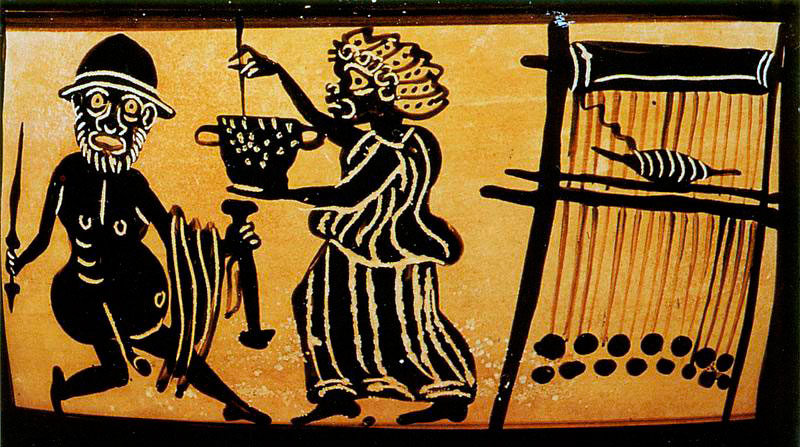Original French: de l’esbatement nocturne de la noble Circe:
Modern French: de l’esbatement nocturne de la noble Circé:
Notes
Circe

Circe gives Odysseus a drugged potion. Black-figure skyphos from Thebes, 5th or 4th c. BCE
Circe
So they stood in the gateway of the fair-tressed goddess, and within they heard Circe singing with sweet voice, as she went to and fro before a great imperishable web, such as is the handiwork of goddesses, finely woven and beautiful, and glorious.
Homer (8th Century B.C.),
Odyssey. Volume I: Books 1-12. A. T. Murray, translator. Cambridge, Massachusetts: Harvard University Press, 1909. 10.221, p. 375.
Loeb Classical Library
Circe
Now good Aeneas, when the last rites were duly paid and the funeral mound was raised, as soon as the high seas were stilled, sails forth on his way and leaves the haven. Breezes blow on into the night, and the Moon, shining bright, smiles on their voyage; the sea glitters beneath her dancing beams. The next shores they skirt are those of Circe’s realm [Circeii, a promontory of Latium, but once an island, is identified by Virgil with Homer’s island of Aeaea, the home of Circe], where the wealthy daughter of the Sun thrills the untrodden groves with ceaseless song and in her proud palace burns fragrant cedar to illuminate the night, while she drives her shrill shuttle through the fine web. From these shores could be heard the angry growls of lions chafing at their bonds and roaring in midnight hours, the raging of bristly boars and caged bears, and huge wolfish shapes howling. These were they whom, robbing them of their human form with potent herbs, Circe, cruel goddess, had clothed in the features and frames of beasts. But so that the pious of Troy should not suffer so monstrous a fate on entering the harbour and setting foot on the accursed shore, Neptune filled their sails with favouring winds, giving them flight, and bore them past the seething shallows.
Virgil (70 – 19 BC),
Aeneid. Books 7-12. George Patrick Goold (1922–2001), translator. Cambridge, Massachusetts: Harvard University Press, 1918. 7.5.
Loeb Classical Library
esbatement
A sporting, playing, dallying, ieasling, recreation
Cotgrave, Randle (–1634?),
A Dictionarie of the French and English Tongue. London: Adam Islip, 1611.
PBM
esbatement
Esbatement, divertissement:
Atant es Gaudifer mouit effraement,
Caldains et Arabis les banieres au vent
Qui oient les grans cops et le martelement;
Certes, dient li Grieu, a nostre entendement
Encour n’avons vue si bel tournoiement;
Or les laissons .I. poi en cest esbaitement.
— Venus dou paon, Richel. 1554
Godefroy, Frédéric (1826–97),
Dictionaire de l’ancienne langue Française. Et du tous ses dialectes du IXe au XVe Siècle. Paris: Vieweg, Libraire-Éditeur, 1881-1902.
Lexilogos – Dictionnaire ancien français
Circe
Homer Od, x 221-3; Virgil Aeneid vii. 10-14.
Rabelais, François (1483?–1553),
The Five Books and Minor Writings. Volume 1: Books I-III. William Francis Smith (1842–1919), translator. London: Alexader P. Watt, 1893.
Internet Archive
Circe
Arguto tenues percurrens pectine telas — Virgile, Énéide, VII, 14.
Rabelais, François (1483?–1553),
Oeuvres. Édition critique. Tome Cinquieme: Tiers Livre. Abel Lefranc (1863-1952), editor. Paris: Librairie Ancienne Honoré Champion, 1931. p. 346.
Internet Archive
Circe
L’enchanteresse Circé est plus connue par la métamorphose des compagnons d’Ulysse en pourceaux (Odyssée, x, 203 sqq.) que pas ses talents de fileuse, évoqués cependant par Virgile (Énéide, VII, 14).
Rabelais, François (1483?–1553), Le Tiers Livre. Pierre Michel, editor. Paris: Gallimard, 1966. p. 560.
de l’esbatement nocturne de la noble Circe:
This phrase added in the edition of 1552.
Rabelais, François (1483?–1553), Le Tiers Livre. Pierre Michel, editor. Paris: Gallimard, 1966. p. 560.
de l’esbatement nocturne de la noble Circé:
Virgile, Énéide, VII, v. 14; addition de 1552 (var. b).
Rabelais, François (1483?–1553), Œuvres complètes. Mireille Huchon, editor. Paris: Gallimard, 1994. p. 503, n. 3.
Circe
C’est Virgile, Enéide, VII, 14, qui occupe, la nuite, Circé à cette tâche («Arguto tenuis percurrens pecctine telas»).
Rabelais, François (1483?–1553), Le Tiers Livre. Edition critique. Jean Céard, editor. Librarie Général Français, 1995. p. 452.
ébattement
Divertissement, distraction, amusement

